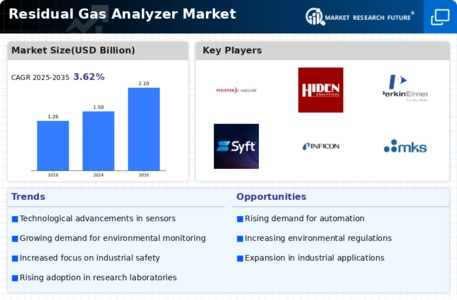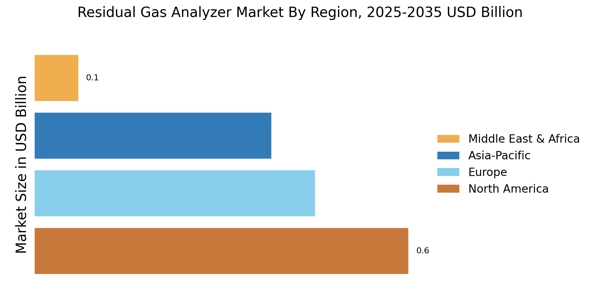Stringent Environmental Compliance
The implementation of stringent environmental regulations is likely to propel the Residual Gas Analyzer Market forward. Governments and regulatory bodies are increasingly mandating the monitoring of emissions and pollutants to mitigate environmental impact. This regulatory landscape compels industries to invest in advanced gas analysis technologies to ensure compliance with legal standards. For instance, the European Union's directives on air quality and emissions have led to a surge in demand for residual gas analyzers. The market is expected to witness a significant uptick as companies strive to meet these regulations, with projections indicating a potential market growth of 6% annually as industries prioritize sustainability and environmental responsibility.
Expansion of Industrial Applications
The expansion of industrial applications for residual gas analyzers is a notable driver for the Residual Gas Analyzer Market. Industries such as automotive, semiconductor manufacturing, and waste management are increasingly recognizing the importance of gas analysis in their operations. The need for accurate monitoring of residual gases in these sectors is essential for ensuring product quality and operational efficiency. As industries continue to evolve and diversify, the demand for specialized gas analysis solutions is expected to rise. Market analysts project a growth rate of approximately 6% in the coming years, reflecting the increasing integration of residual gas analyzers in various industrial processes.
Rising Demand for Process Optimization
The increasing emphasis on process optimization across various industries appears to be a key driver for the Residual Gas Analyzer Market. Industries such as petrochemicals, pharmaceuticals, and food processing are increasingly adopting advanced analytical techniques to enhance efficiency and reduce waste. The need for precise monitoring of residual gases ensures that processes remain within optimal parameters, thereby improving product quality and operational efficiency. As a result, the market for residual gas analyzers is projected to grow, with estimates suggesting a compound annual growth rate of around 5% over the next few years. This trend indicates a robust demand for reliable and accurate gas analysis solutions, which are essential for maintaining competitive advantage in a rapidly evolving industrial landscape.
Technological Innovations in Gas Analysis
Technological innovations in gas analysis are transforming the Residual Gas Analyzer Market. The advent of sophisticated sensors and real-time monitoring systems enhances the accuracy and reliability of gas measurements. Innovations such as miniaturized sensors and wireless communication technologies are making residual gas analyzers more accessible and user-friendly. These advancements not only improve measurement precision but also reduce operational costs for industries. As technology continues to evolve, the market is likely to expand, with forecasts suggesting a growth rate of approximately 7% in the coming years. This trend indicates a strong inclination towards adopting cutting-edge technologies that facilitate better gas analysis and monitoring.
Growth in Research and Development Activities
The surge in research and development activities across various sectors is contributing to the expansion of the Residual Gas Analyzer Market. Academic institutions and research organizations are increasingly focusing on developing new materials and processes that require precise gas analysis. This trend is particularly evident in sectors such as aerospace, energy, and materials science, where understanding gas composition is crucial for innovation. The market is expected to benefit from increased funding and collaboration between industry and academia, potentially leading to a growth rate of around 5% over the next few years. This collaborative environment fosters advancements in gas analysis technologies, further driving market demand.


















Leave a Comment